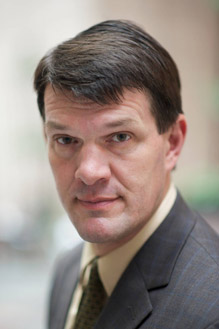If the three rules of real estate are location, location, location, the three rules of copyright protection should be: get it in writing, get it in writing, get it in writing. A recent copyright case against the famed glass sculptor Dale Chihuly illustrates the pitfalls of failing to document the relationship of parties creating copyrightable works.
For decades Chihuly has created enormous glass sculptures and paintings using teams of assistants. Chihuly would give the assistants general directions for backgrounds and other preliminary work. After the assistants followed his initial instructions, Chihuly would complete the sculptures and paintings himself or provide more detailed instructions for the assistants to complete the final steps and ensure that they were completed in Chihuly’s iconic style. (Chihuly has suffered from health problems for years that have impacted his ability to personally engage in all the physical tasks necessary to fulfill his artistic visions).
Michael Moi was one of Chihuly’s assistants and worked for him from 1999 to 2014. He was not, however, an employee. Chihuly told Moi that he would be compensated for his time, and that his staff was tracking Moi’s work and time spent working for Chihuly. Moi later admitted that he had no agreement as to the amount of compensation he would receive or when Chihuly would pay him.
In late 2016, after a falling out between Chihuly and some assistants, including Moi, Chihuly repudiated his promise to pay Moi, who in turn sued Chihuly in 2017. In the lawsuit Moi sought a declaration that he was the coauthor of 285 artworks produced under Chihuly’s name as well as compensation for his copyrightable contributions to the work. Moi v. Chihuly Studio, Inc., Case No. C17-0853RSL (W.D. Wash. 2019).
In granting Chihuly’s motion for summary judgment, the court first examined whether Moi was a joint author of the paintings under Section 201(a) of the Copyright Act. A threshold question for a determination of joint authorship is whether the party seeking the declaration made an “independently copyrightable contribution” (citing Richlin v. Metro-Goldwyn-Mayer Pictures, Inc., 531 F.3d 962, 968 (9th Cir. 2008)).
In evaluating Moi’s claim, the court relied on the Ninth Circuit’s test for determining coauthorship set forth in Aalmuhammed v. Lee, 202 F.3d 1227, 1234 (9th Cir. 2000). The Aalmuhammed test examines (1) whether the claimed author exercised control over the work at issue, (2) whether the parties expressed “objective manifestations of a shared intent to be coauthors,” and (3) if “the audience appeal of the work turns on both contributions and the share of each in its success cannot be appraised.
The court determined that each Aalmuhammed factor weighed in favor of Chihuly. As for control, while Moi painted some backgrounds, Chihuly determined the look and characteristics of the most prominent parts of the paintings, and he alone determined if the paintings would be displayed, sold or destroyed – he exercised total control over the “publication and commercialization” of the paintings. Accordingly, Moi did not exercise control over the works. The court then found that there was no objective evidence of an intent that Moi was a coauthor with Chihuly: no written agreement documented such an intent; there was no evidence of an oral agreement; Chihuly alone selected which works were to be sold, and he then signed them as the sole artist and presented them to the public as his own works, with no acknowledgment or credit to Moi. Finally, there was no evidence that Moi contributed to the market appeal of the 285 paintings: their market and market value “derived largely from Chihuly’s name and iconic style,” and Moi admitted that he painted the backgrounds to imitate Chihuly’s style while acceding to Chihuly’s efforts to keep the participation of Moi and the other assistants secret. Given the overwhelming evidence that there was no joint authorship, the court found against Moi on all counts.
Because the Aalmuhammed test relies heavily on which party manifested control over the work or works in dispute, some courts have criticized this approach for allowing bad actors to seize control over a work and then claim that their wrongful control is evidence of sole authorship. For this reason, some circuits discount control as an element of joint authorship, and practitioners seeking to assert joint authorship claims may seek a jurisdiction with a more friendly test. For example, the Second and Seventh Circuits focus only on whether the co-author made independently copyrightable contributions and if the parties intended to be coauthors. See Thomas v. Larson, 147 F.3d 195, 200 (2d Cir. 1998), and Erickson v. Trinity Theatre, Inc., 13 F.3d 1061, 1068-71 (7th Cir. 1994).
After the dismissal, Chihuly received an award of almost $1.6 million in attorney’s fees for his successful defense of Moi’s suit. It remains to be seen if Chihuly will ever collect his fees from Moi, but even a basic written agreement between Chihuly and Moi, one that just set forth the basic parameters of their relationship, might have foreclosed the entire lawsuit or at least provided grounds for dismissal without discovery. Instead, the parties saved perhaps a few hundred dollars on a contract up front only to then spend millions in attorney’s fees litigating the dispute.

